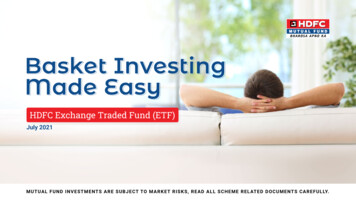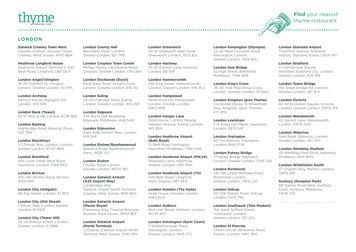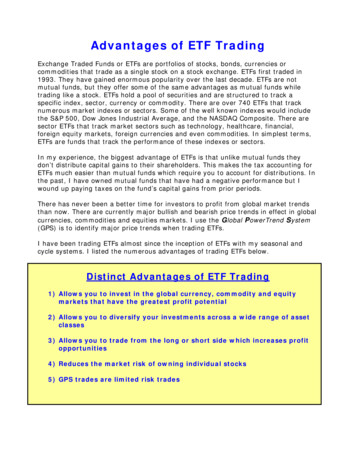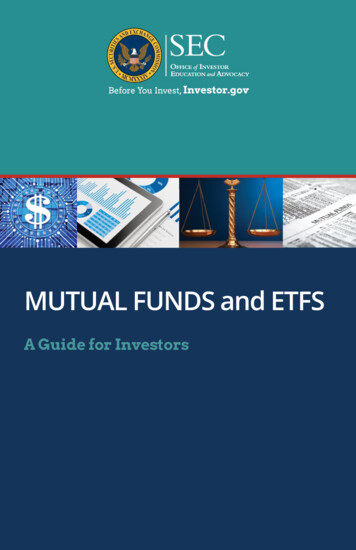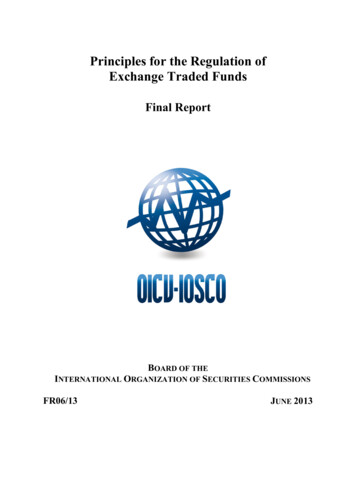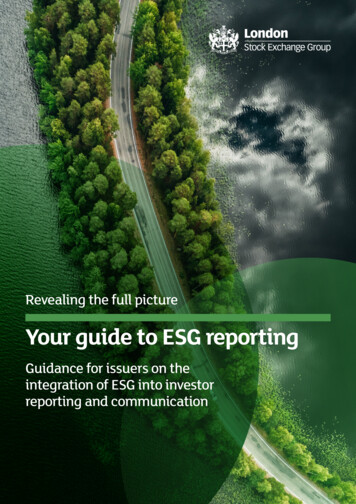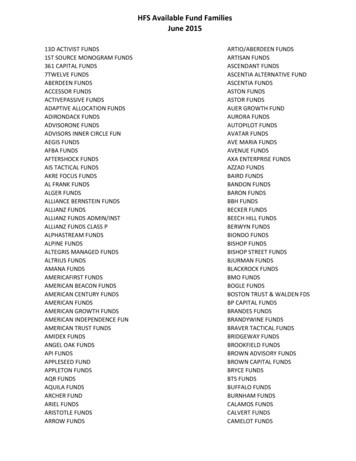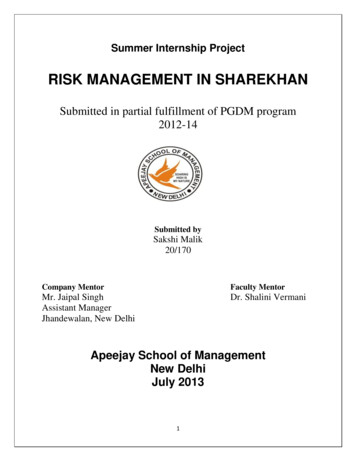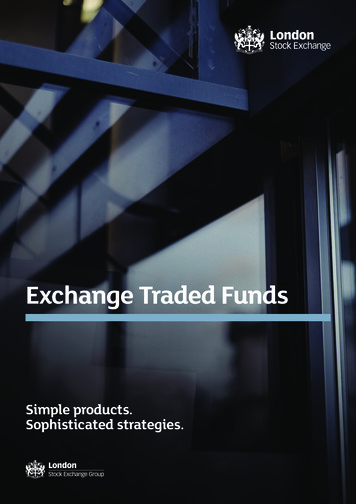
Transcription
Exchange Traded FundsSimple products.Sophisticated strategies.
ETFsExchange Traded Funds (ETFs) areessentially straightforward index-trackinginstruments but in the hands of a skilfulprofessional investor they become thebuilding blocks of sophisticated investmentstrategies. Institutional use of ETFs hasgrown almost exponentially in the US overthe past decade – and European institutionsare now driving similar growth across theEU. As the range of ETFs available on LondonStock Exchange has grown, so too has thepotential for executing more interestingand intricate strategies.
Capabilities and strengths1000 ETFs andETPs listedETFs are now tracking global, country-specific and asset-specific indices, covering avariety of asset classes including commodities, high-yield equities and bonds – bringingsimplicity, flexibility and cost-effectiveness in their wake. It’s no surprise that ETFs arebeing used more widely by creative investment professionals everywhere.FlexibilityETFs can be used in a number of ways – either on theirown to gain exposure to an index, or in combination withother products as part of more complex strategies. Oneof their key strengths is that they free you up to focus onyour area of core expertise by providing broad exposureto an index. ETFs can play a key part in core-satellitestrategies and tactical asset allocation, as well as havingmany other uses, as outlined on page 03.Wide range of underlyingETFs are not restricted to European blue-chip indices – theybring a wide range of investments within reach that mightotherwise be difficult to access efficiently. This makes itcost-effective to trade emerging markets over a short timehorizon, or to swap out of UK and into Eurobonds in just twotrades, for example. A full list of current ETFs traded onLondon Stock Exchange is available on our website.Trades like a share, as liquid as the underlyingETFs offer full exposure to international and domesticindices with just one trade, and settle in Euroclear UK& Ireland Limited (formerly CREST Co) with on-book tradesoffering the protection of the central counterparty service.Furthermore, the liquidity of the ETF itself is immaterial– ETFs are as liquid as the underlying index constituentsbecause you can exchange the underlyings for ETFs ona daily basis (see diagram on page 02). This means that anETF can provide easily accessible exposure to many indiceswhere the future is illiquid. There is also usually fulldividend participation, with income paid via Euroclear.“ETFs bring a wide range ofinvestments within reach thatmight otherwise be difficultto access efficiently.”01Exchange Traded Funds / Simple products. Sophisticated strategies.
Capabilities and strengths0ETF mechanicsSecondary marketPrimary marketstamp dutyBasket ofsecuritiesCashInvestorBrokerETF marketmakersExchangeETFETFcustodianETF creationunitsCashSecuritiesCapitalmarketsLow tracking errorETFs combine the tradability of investment trusts withthe tracking precision of unit trusts – this minimal trackingerror is achieved through the arbitrage opportunities whicharise when the ETF trades away from Net Asset Value (NAV).This is a function of the creation/redemption processwhereby the basket of securities that makes up the indexcan be exchanged for an ETF on a daily basis, and viceversa (see diagram, above).Best EuropeanExchange forListing ETFsETFs are not derivativesFund managers without a derivatives mandate may havedifficulty finding a means of investing in an index whilstavoiding the cost and complex settlement often associatedwith program trades. ETFs are classified as a regular securityand are Collective Investment Schemes. In addition,most ETFs are UCITS III compliant.Because ETFs are not derivatives, they do not require anydaily margin calculation or mark-to-market, and can betraded using existing systems without the need for furtherrisk assessment tools.No stamp dutyTrading is tax efficient as ETFs are free of UK stamp dutyin the secondary market.ETF Express Awards 201302–03Exchange Traded Funds / Simple products. Sophisticated strategies.
ETFs – the simple trade behindsophisticated strategiesETFs trade like anequity, buy and sellon the same dayMore investment professionals are discoveringnew ways in which ETFs can form the buildingblocks of investment strategies. Some of theways ETFs can be used to enhance returnsare outlined below.ShortingBecause ETFs trade just like a share, it’s possible to shorta whole index simply by shorting the ETF. The SB&L marketfor ETFs is constantly growing, ensuring ETFs are readilyavailable to borrow in order to meet shorting obligations.Core-satellite strategyThis common asset allocation strategy involves investinga large portion of a portfolio (the ‘core’) in a passiveproduct to achieve beta – profiting from the systematicrisk or volatility inherent in a particular index – whilstactively investing the remaining assets (the ‘satellite’)to achieve abnormal returns attributable to manager skill.Owing to their low tracking error, ETFs have been popularas the ‘core’ element for some time; but now, with ETFsbased on narrower and more specific indices, managerscan actively trade ETFs as elements of the satellite to gainalpha returns. In fact, some managers invest exclusivelyin ETFs.Pairs tradingWith such a wide range of ETFs now available, there aremany ways they can be used in pairs trading strategies.Shorting the stock whilst going long on the ETF, or viceversa, captures the relative outperformance of the longposition over the short. You can even use ETFs for both legs:if it is predicted that Taiwan could outperform the emergingmarkets index for example, then it’s possible to go longon the MSCI Taiwan ETF and short on the MSCI EmergingMarkets ETF (for illustrative purposes only).Cash equitisationBecause they are so easily tradable, ETFs can be used toeliminate the cash drag which often results from unexpectedor significant capital inflows. Additionally, ETFs can be anefficient way of achieving instant investment in an indexwhilst you seek out the specific opportunities within it.Tactical asset allocationETFs make tactical asset allocation easy. It’s possibleto gain instant access to a whole index with a single trade.This extends a fund manager’s investment capabilitiesto a wide variety of different markets such as Japan,emerging markets, high yield stocks or corporate bonds.Swapping between Europe and the emerging markets,for example, can be achieved in just two trades.Recover the management fee through lendingLending ETFs to institutions that have taken short positionsmitigates the management fee, whilst still maintainingexposure to the index. The income generated from thiscan cover a very significant portion of the annualmanagement fee.02–03HedgingETFs are perfect for hedging long or short exposure, bygoing short or long on the ETF respectively. Hedging usingthe wide variety of ETFs available on London Stock Exchangecan be both effective and efficient, particularly where thefuture is relatively illiquid. Additionally, ETFs do not requirequarterly rolls or margin maintenance, reducing theadministrative burden and cost of hedging. 30Exchange Traded Funds / Simple products. Sophisticated strategies.%of European on-exchangeETF turnover is on LondonStock Exchange
ETFs versus futuresLiquid andcost-effectiveThere are many instruments which provide exposure to indices, but few provide the simplicity andflexibility of ETFs. As outlined in the table below, ETFs have a number of key advantages over futures:—— There is no need to roll the contract each quarter – the associated savings often significantlyoutweigh an ETF’s annual management fee——There is no need to calculate daily variation margin—— Liquidity is limited only by the liquidity of the underlying index constituents.ETFsFuturesFinancial instrumentStock t liquidityEqual to liquidity of underlying stocksVariable – based on demand/supplyMatuarityNoneLimited lifespanReinvestment riskNoneYesShort salesYesYesCosts for purchase/saleNormal Exchange feesInitial and variation margin payments and rollover costsMinimum order size1 ETF (ca 30) 10 index (ca. 50,000)Dividend paymentGenerally quarterly payment via EuroclearCash settlement at maturityMargin managementNoRequiredManagement feeYesNoPotential for lending revenueYesNoConclusionETFs. Simple products. Sophisticated strategies.This brochure presents just some of the opportunitiesETFs offer the skilful investment professional. The flexibilityof ETFs is shown in their many uses – and is temperedonly by your imagination.ContactFor further information on how ETFs can benefit theprofessional investor contact the product managerat etfs@lseg.com04Exchange Traded Funds / Simple products. Sophisticated strategies.30%increase in ETFand ETP turnover,H1 2013 vs H1 2012
Largest ETF Exchangein Europe by volumeRecognised by Global ETF Awards 2013
London Stock ExchangeLondon Stock Exchange plc10 Paternoster SquareLondon EC4M 7LSTelephone 44 (0)20 7797 1000www.lseg.comThe information contained in this publication is for guidance only and London Stock Exchange plc shall not be liable for decisions made in reliance on it. The price of ETFs may go downas well as up and you should seek the advice of professional advisers before investing in ETFs. London Stock Exchange crest and logo, are trademarks of London Stock Exchange plc. November 2013 London Stock Exchange Group plc. Registered in England & Wales No 02075721.
London Stock Exchange London Stock Exchange plc 10 Paternoster Square London EC4M 7LS Telephone 44 (0)20 7797 1000 www.lseg.com The information contained in this publication is for guidance only and London Stock Exchange plc shall not be liable for decisions made in reliance on it. The price of ETFs may go down
